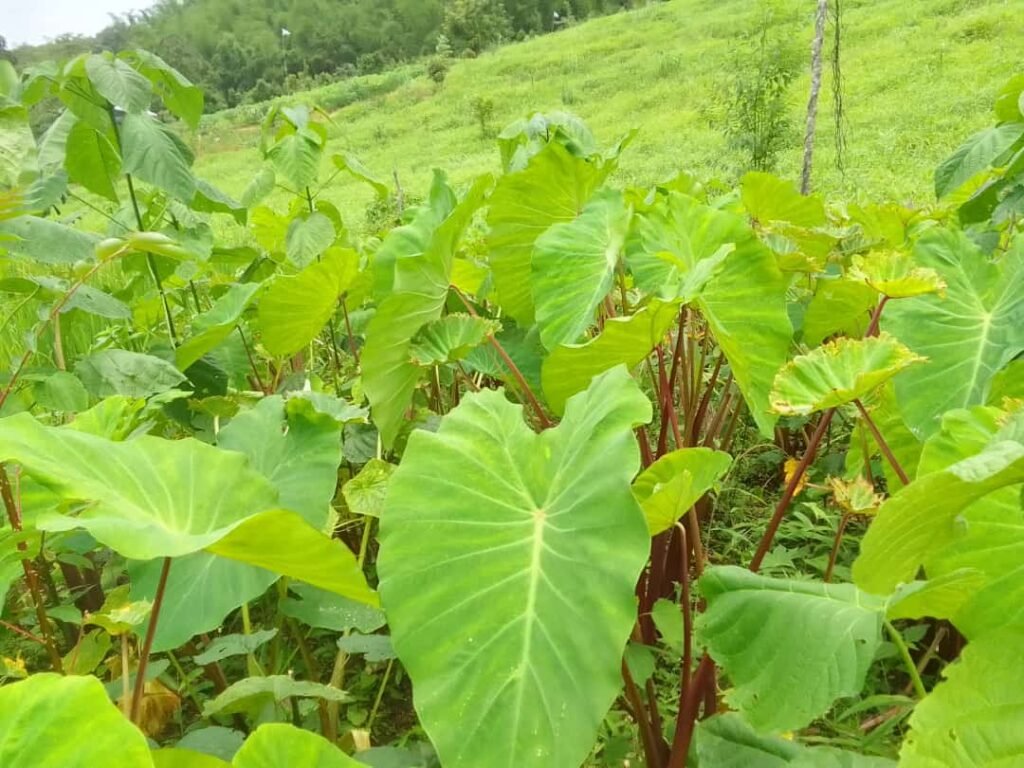Anishi is a traditional delicacy of the Ao-Nagas belonging to Nagaland of Northeast India. Today, it is enjoyed by many people of different cultures and region. The word ‘Anishi’ is believe to be the corrupted form of original Ao word ‘Nuoshi/ Nuushi’ which basically mean ‘Fermented taro leaves’. ‘Nu-O’ meaning Taro leaf and ‘shi’ meaning ‘fermented’. Today, the delicacy is popularized as Anishi and is the most accepted form to describe this processed traditional culinary craft.
Anishi made from fermented and dried Colocasia leaves is a labor of love that requires skill, patience, and a deep connection to the land. Anishi is not just a culinary delight but it’s a cultural symbol that carries the flavours of tradition.
Let’s delve into the intricate process of making Anishi, where nature’s bounty is transformed into a cherished delicacy.
How to make Anishi?
1. Harvest the taro Leaves
The journey of Anishi begins with the careful selection of Colocasia Taro leaves. The best time to make Anishi is between May and September. The leaves are plucked from the plant, ensuring that only the freshest and healthiest ones are chosen. These leaves will become the canvas for the transformation ahead.

- Cleaning and storing for fermentation
The harvested leaves are thoroughly cleaned and made to wilt slightly by keeping it under the shade. The leaves are then packed in a gunny bag and kept in a cool shade away from sunlight for a day. The leaves are emptied from the gunny bag again into a mat and the water droplets from the leaf surface accumulated as a result of transpiration are shaken off. After which the leaves are then shove inside the bag again and kept for 3-4 days away from sunlight until the taro leaves turn yellow.
- Pounding
After the leaves turn yellow, pounding is employed using a traditionally made large wooden pestle and mortar. The fermented leaves are pounded into a dark forest green paste. The visible fibrous chords are removed from the ground paste and is wrapped in a banana leaf and kept for 8-10 hours.

- Cooking
The paste then is cooked into soft dough either in a hot water bath for 3-4 hours or baked by ash cooking method over the fireplace overnight.
- Sun-Drying:
Once they’re cooked/ baked, it is again pounded to make it into softer dough. After which they are flattened into patties of desired shape and sizes. Usually, it is made into rounds. The patties then are taken out to dry in the sun. Traditionally, they are placed in a net tray and smoked over the wood fire, however, due to health safety concerns the newer generation prefer sun dried Anishi.

This step helps to preserve the leaves, enabling them to be stored for an extended period of time. Sun-drying contributes to the development of the unique taste and texture of Anishi and smoking imparts a smoky aroma and flavor.
- Storage
With the drying complete, the Anishi patties are ready for storage. These can be stored for months, at least 24 months without losing their taste and texture, if stored in right conditions like air tight containers.
- Culinary creations
Anishi, in its final form, can be used in various culinary creations. Before drying, chili, pepper, ginger and salt can be added to the paste. This chutney form but dried can be consumed as a chewy accompaniment. The dried chutney form patties are also pounded into powder form.
One of the most popular dishes made of Anishi is the ‘Smoked pork with Anishi’. This culinary craft has become a sensation among food enthusiasts receiving rave reviews both nationally and internationally.

Other than that it’s often made into spicy stews with just chilies, tomatoes, bamboo shoot juice and salt accompanied by various herbs providing a unique twist.
The process of preserving does not involve any addition of added flavours or preservatives thus making it a safe and wonderful age-old culinary delight.
The process of making Anishi testifies the knowledge and skills passed down through generations. As you savor this delicacy, remember that behind its rich flavour lies a heritage deeply rooted in nature, tradition, and the culinary artistry of Northeast India’s Nagaland..
Here is a clip to watch which might help you in making this Anishi from scratch for you and your family albeit not in the most indigenous way!
With the hope that you get to savor this culinary delight at least once in your lifetime!
Sharing is caring. You know what to do!




